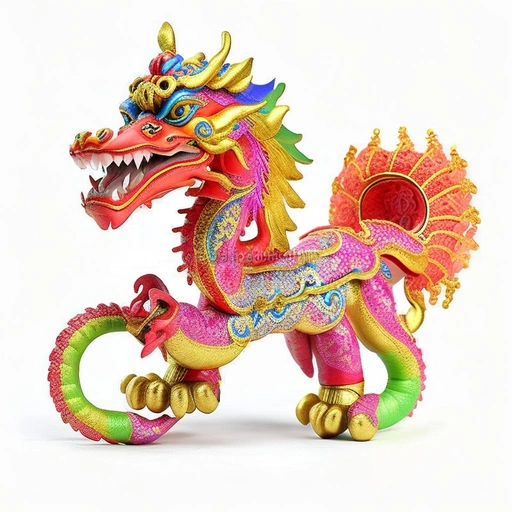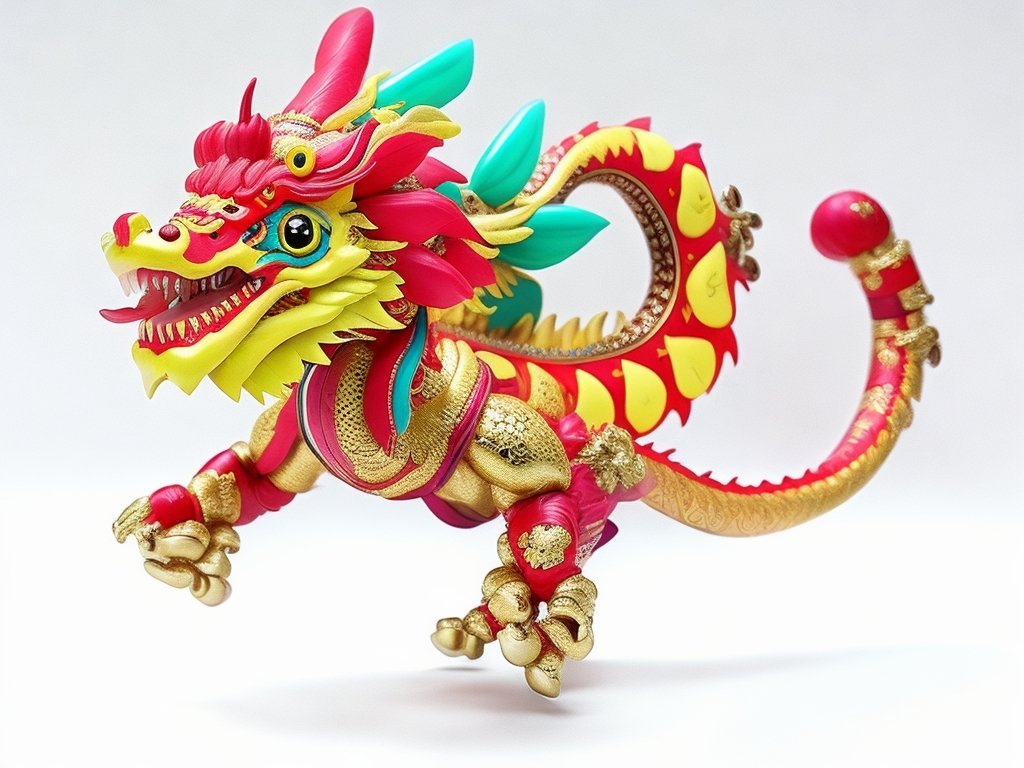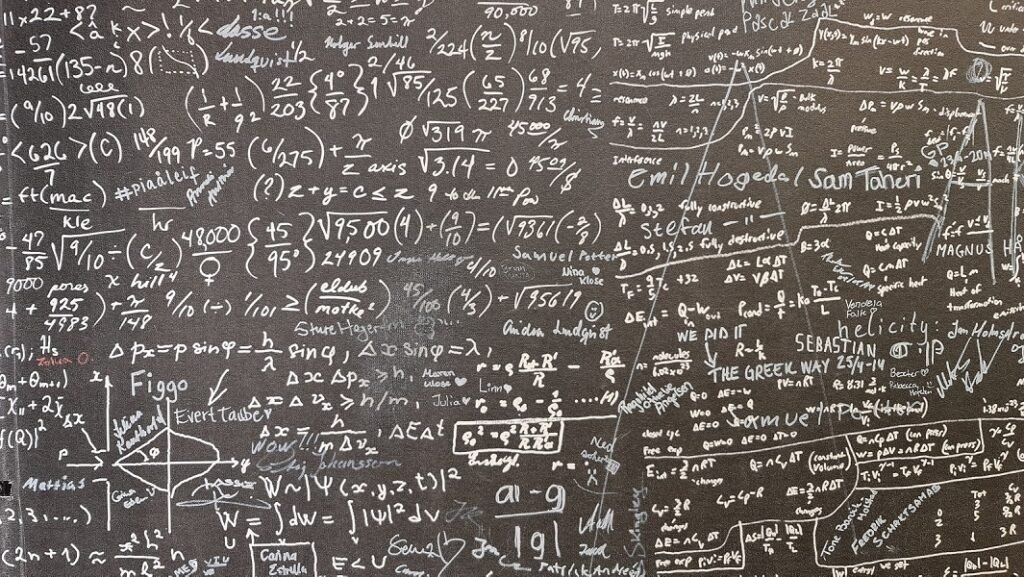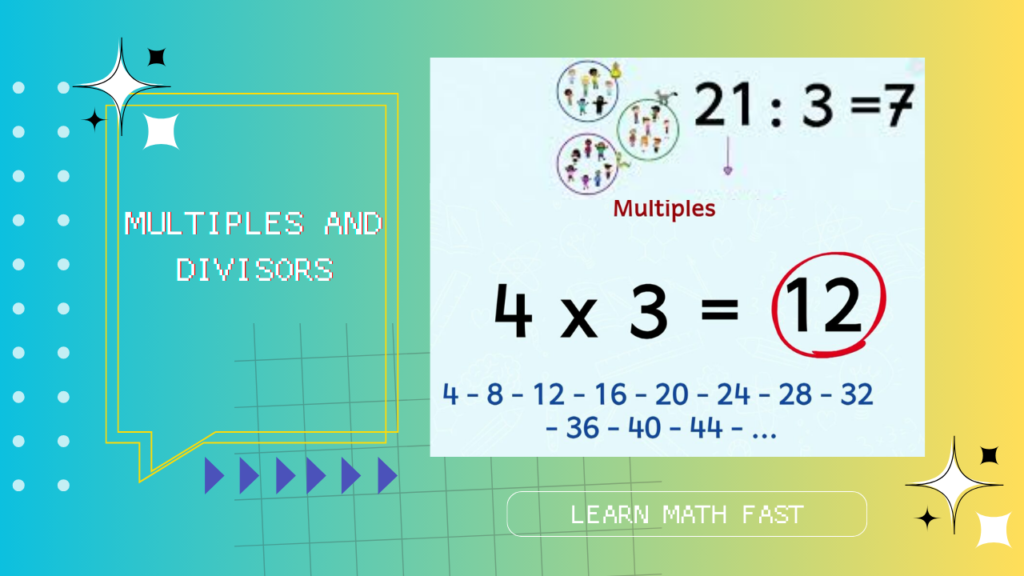Today, we will embark on an exciting learning adventure that revolves around the mesmerizing Chinese Dragon Dance and use this captivating art form as the inspiration for our lesson on multiplying fractions.
The Chinese Dragon Dance: An Overview
The Chinese Dragon Dance is a cultural treasure that has been practiced for centuries in China and has since spread to other parts of the world. The dance involves a team of performers holding up the long dragon figure using poles, moving and swaying it in rhythm with the drums, gongs, and cymbals. The dragon figure is usually painted in vibrant colors, with intricate designs and patterns that represent good fortune and prosperity.
The dance typically begins with the performers carrying the dragon through the streets, accompanied by the loud and rhythmic beats of the accompanying musical instruments. The dragon is said to awaken from its slumber during the dance, and as it moves, it is believed to bless the people with good luck and fortune for the coming year.
The dragon dance is not only a celebration of Chinese culture but also a symbol of unity and community spirit. The performers work together in unison to create the illusion of a dragon coming to life, moving in perfect synchronization with the music and each other. It is a beautiful display of teamwork, coordination, and skill.
The dragon dance is also steeped in symbolism. The dragon is considered to be a powerful and auspicious creature in Chinese mythology, symbolizing strength, prosperity, and good luck. The dragon is believed to have control over water and the weather, making it a symbol of agriculture and the hope for a bountiful harvest. The dragon is also associated with the emperor and is a symbol of imperial power and authority.
Connecting The Chinese Dragon Dance with Multiplying Fractions and Art Course
The Chinese Dragon Dance provides an excellent opportunity to introduce the concept of multiplying fractions and the art course in a unique and engaging manner. Let’s imagine that we are skilled in ancient China, tasked with creating a new dragon figure for an upcoming celebration. To make our dragon distinct and memorable, we will use different fractions to represent the various elements of the dragon, such as the length, width, and color patterns.
Multiplying Fractions Basics
Step 1: Understand the concept. When we multiply fractions, we are essentially finding the product of two or more fractions. This can be visualized as finding the area of a rectangle, with one fraction representing the length and the other representing the width.
Step 2: Multiply the numerators. To multiply fractions, we first multiply the numerators (the top numbers) of the fractions. For example, if we have the fractions 2/3 and 4/5, we multiply the numerators 2 and 4 to get 8.
Step 3: Multiply the denominators. Next, we multiply the denominators (the bottom numbers) of the fractions. In our example, we multiply the denominators 3 and 5 to get 15.
Step 4: Simplify the result. Once we have multiplied the numerators and denominators, we simplify the resulting fraction if necessary. In our example, the result is already simplified: 8/15.
The example above is straightforward. However, when multiplying fractions, you may wonder about the following cases.
- Multiplying fractions with different denominators
- Multiplying fractions with the same denominator
- Multiplying fractions with whole numbers
- Multiplying fractions with mixed numbers
- Multiplying improper fractions
Depending on which situation(s) you encounter, there are rules to follow when you multiply fractions.
Rules of multiplying fractions
Rule 1: The most important rule is to multiply straight across. In other words, multiply the numerators to get the new numerator or the numerator of the product. Multiply the denominators to get the new denominator or the denominator of the product.
Rule 2: Another important rule is to always convert mixed fractions, also called mixed numbers into improper fractions before multiplying.
Rule 3: Convert whole numbers into fractions before doing multiplication.
Rule 4: Multiplying fractions is not the same as adding fractions. Therefore, you must not look for common denominators!
Rule 5: Simplify the product or write the fraction you end with after performing multiplication in lowest terms if needed.
Multiplying fractions with different denominators
Understanding how to multiply fractions with different denominators can be a game-changer when it comes to tackling more complex mathematical problems. While adding fractions requires finding a common denominator, multiplying fractions operates under a different rule. Let’s explore this concept further with an example involving the fractions 1/5 and 2/3.
Step 1: Multiply the numerators To start, multiply the numerators of the fractions together: 1 × 2 = 2.
Step 2: Multiply the denominators Next, multiply the denominators of the fractions together: 5 × 3 = 15.
Step 3: Simplify the result Now, we have the product of the fractions, 2/15. In this case, the fraction is already written in its simplest form or lowest terms since the greatest common factor of 2 and 15 is 1. Hence, we don’t need to simplify it further.
Putting it all together, we have:
1/5 × 2/3 = (1 × 2)/(5 × 3) = 2/15.
By following these steps, we can confidently multiply fractions with different denominators without the need to find a common denominator. This approach simplifies the process and allows us to obtain the correct result efficiently.
Remember, when multiplying fractions with different denominators, focus on multiplying the numerators and multiplying the denominators separately. This rule differs from adding fractions, where finding a common denominator is essential. So, embrace the unique rule for multiplying fractions and confidently navigate the world of fraction mathematics!
Practice exercises and real-life examples can further solidify your understanding of multiplying fractions with different denominators. By incorporating hands-on activities and visual aids inspired by Chinese art, you can make the learning experience both educational and enjoyable. Let’s continue exploring the fascinating world of fractions and empower ourselves with valuable mathematical skills!
Multiplying fractions with the same denominator
When you multiply fractions with the same denominator, just do the same thing you do when the fractions have unlike denominators.
Example: Multiply 3/4 and 1/4
3/4 × 1/4 = (3 × 1)/(4 × 4) = 3/16
Multiplying fractions with whole numbers
When you multiply fractions with whole numbers, just keep in mind rule 3 stated above. Convert the whole number into a fraction before doing multiplication.
Notice that any whole number x can be written as a fraction x/1 since any number divided by 1 will return the same number.
For example if you multiply the whole number 5 by another fraction, write 5 as 5/1 before you multiply.
Example: Multiply 5 and 2/3
5 × 2/3 = 5/1 × 2/3
5 × 2/3 = (5 × 2)/(1 × 3) = 10/3
Multiplying fractions with mixed numbers
When multiplying fractions with mixed numbers, it is important to remember rule 2. You must first convert any mixed number into a fraction before you multiply.
Suppose you are multiplying a fraction by 2 1/3. Since 2 1/3 is a mixed number, you must convert it into a fraction.
2 1/3 = (2 × 3 + 1)/3 = (6 + 1) / 3 = 7/3
Example: Multiply 1/6 and 2 1/3
1/6 × 2 1/3 = 1/6 × 7/3
1/6 × 7/3 = (1 × 7)/(6 × 3) = 7/18
Multiplying improper fractions
The multiplication of improper fractions is performed by following rule 1. Just multiply straight across. One thing you definitely do not want to do here is to convert the improper fractions to mixed numbers.
This will be very counterproductive as you will have to convert them right back into improper fractions.
Example: Multiply 9/2 and 3/5
9/2 × 3/5 = (9 × 3)/(2 × 5) = 27/10
Going a little deeper! Why do we multiply fractions straight across?
When we multiply fractions, we multiply the numerators together and the denominators together. This may seem like a simple rule to follow, but it’s crucial to understand why we multiply fractions straight across.
Let’s take an interesting example to help explain this concept. Imagine you’re preparing a batch of cookies, and the recipe calls for 3/4 cup of flour and 1/3 cup of sugar. You need to double the recipe, but you want to know how much flour and sugar you’ll need.
To solve this problem, we need to multiply 3/4 by 2 and 1/3 by 2. But why do we multiply straight across?
We can visualize fractions as parts of a whole. In the case of the cookie recipe, 3/4 cup of flour represents three-quarters of a cup of flour out of a whole cup, and 1/3 cup of sugar represents one-third of a cup of sugar out of a whole cup.
When we double the recipe, we need two whole cups of flour and two whole cups of sugar. Therefore, we need to find how many parts of a whole cup of flour and sugar we need, which is where multiplication comes in.
By multiplying 3/4 by 2, we find that we need 6/4 cups of flour, which simplifies to 1 1/2 cups. Similarly, by multiplying 1/3 by 2, we find that we need 2/3 cup of sugar.
The reason we multiply straight across is that we’re essentially multiplying the fractions’ parts of a whole together. When we multiply the numerators, we’re finding how many parts of a whole we need, and when we multiply the denominators, we’re finding the size of those parts.
So, in the case of our cookie recipe, multiplying fractions straight across allows us to find how much flour and sugar we need to double the recipe accurately. Understanding why we multiply fractions straight across is crucial in not only baking but also in many real-life situations, making it a fundamental skill in math.
Multiplying fractions quiz. Check to see if you can now multiply fractions.
The height of the Chinese Dragon Dance performer is 1.5 meters. If the performer needs to wear stilts that are 2/3 of their height, how tall are the stilts?
Answer: 1.5 * 2/3 = 1 meter
The Chinese Dragon Dance team plans to perform on a stage that is 4/5 of a meter above the ground. If they need to build steps that are 3/4 of a meter high to reach the stage, how high should each step be?
Answer: 4/5 * 3/4 = 12/20 = 3/5 meter
The Chinese Dragon Dance costume requires 2.5 meters of fabric for each performer. If there are 8 performers in the team, how much fabric is needed in total?
Answer: 2.5 * 8 = 20 meters
In a Chinese Dragon Dance, a group of dancers are holding a long dragon made up of several sections. If each dancer is holding 1/4 of the total length of the dragon, and there are 8 dancers in total, what fraction of the dragon is being held?
Answer: 2/4 or 1/2 of the dragon is being held.
A Chinese Dragon Dance team is preparing for a performance. They need to create a new dragon that is 5/6 the length of their current dragon. If the current dragon is 48 feet long, how long should they make the new dragon?
Answer: They should make the new dragon 40 feet long.
During a Chinese Dragon Dance, the dragon is paraded through the streets of a city, covering a total distance of 1 mile. If the dragon is made up of 10 sections, and each section covers 1/10 of the total distance, how far does each section of the dragon travel?
Answer: Each section of the dragon travels 1/10 mile or 528 feet.
A Chinese Dragon Dance is being performed for a festival. The dragon is made up of 24 sections, each measuring 1/3 of the total length of the dragon. What fraction of the dragon is represented by 8 of these sections?
Answer: 8 sections represent 8/24 or 1/3 of the dragon.
In a Chinese Dragon Dance, the head of the dragon is made up of 2 sections, each measuring 1/5 of the total length of the dragon. If the entire dragon is 60 feet long, how long is the head of the dragon?
Answer: The head of the dragon is 12 feet long.
The length of the Chinese dragon used in a traditional dance is 3/4 of a kilometer. If the dance team decides to extend the length of the dragon by 1/2, what will be the new length of the dragon?
Answer: The new length of the dragon will be 3/4 * 1/2 = 3/8 of a kilometer.
During a performance, the dragon dancers divide the dragon into 8 equal sections. If each dancer is responsible for 3/4 of a section, what fraction of the dragon does each dancer cover?
Answer: Each dancer covers 3/4 * 1/8 = 3/32 of the dragon.
In a dragon dance competition, Team A performs with a dragon that is 5/6 of the length of Team B’s dragon. If Team B’s dragon is 2/3 of a kilometer long, how long is Team A’s dragon?
Answer: Team A’s dragon is (5/6) * (2/3) = 10/18 = 5/9 of a kilometer long.

the Art of Multiplying Fractions Chinese Dragon Dance Figure
The Art Course: Creating Your Own Dragon Dance Figure
Now that we understand how to multiply fractions, let’s apply this knowledge to our Dragon Dance project. Using fractions, we can determine the proportions and dimensions of our dragon figure, as well as the color patterns and design elements.
- Design the dragon figure’s body: Consider using fractions to represent the length and width of each section of the dragon’s body. For example, if the total length of the dragon is represented by the fraction 1/1 (the whole), you may decide that the head should be 1/4 of the total length, while the tail is 1/6.
- Determine the color patterns: Use fractions to describe the proportions of different colors on the dragon figure. For instance, if you decide to use three primary colors (red, yellow, and blue), you can assign fractions to each color to represent the proportion of that color on the dragon’s body. For example, you could use the fractions 3/7 (red), 2/7 (yellow), and 2/7 (blue).
- Create the dragon’s features: Incorporate traditional Chinese art elements into the design of the dragon’s features, such as its head, tail, and scales. Use fractions to represent the proportions of these features as well.
Applying the Lesson to Our Dragon Dance Figure
Now that we have the context, let’s apply our newfound knowledge of multiplying fractions to our Dragon Dance project. The Dragon Dance is a vibrant and energetic traditional Chinese performance that involves a long dragon figure manipulated by a team of dancers. In this scenario, we will explore how fractions can be used to determine the proportion of the dragon’s head.
Suppose we want to create a dragon figure that combines the proportions of two existing dragons. Dragon A has a head that is 1/4 of its total length, while Dragon B has a head that is 1/6 of its total length. To find the proportion of the new dragon’s head, we can multiply these fractions together.
To do this, we multiply the numerators (1 * 1) and the denominators (4 * 6) separately. This yields the fraction:
(1/4) * (1/6) = (1 * 1) / (4 * 6) = 1/24
Therefore, our new Dragon Dance figure will have a head that is 1/24 of its total length.
This calculation shows us how multiplying fractions allows us to combine different proportions effectively. By multiplying the fractions representing the proportions of the individual dragon heads, we obtain a new fraction that represents the proportion of the head in the final dragon figure.
The resulting fraction, 1/24, indicates that the head of the new dragon will be relatively smaller compared to the overall length of the figure. This proportionate representation is essential for maintaining the aesthetics and balance of the Dragon Dance performance.
By applying the concept of multiplying fractions to our Dragon Dance project, we demonstrate how mathematical thinking can be integrated into artistic and cultural practices. It showcases the practicality of fractions beyond traditional math problems, providing a tangible connection between mathematics and the real world.
As we continue to explore the intersections of math, art, and culture, let’s appreciate the rich heritage of the Dragon Dance and the mathematical principles that underpin its creation. Through such interdisciplinary learning, we not only deepen our understanding of mathematical concepts but also foster a greater appreciation for the diverse and captivating traditions of different cultures.
By integrating the captivating Chinese Dragon Dance with the essential math skill of multiplying fractions and the art course, we have created an engaging, educational, and fun learning experience for parents and children alike. This innovative approach encourages learners to explore the fascinating connections between art, culture, and math, fostering creativity and critical thinking. We hope this exciting learning adventure inspires you to delve deeper into the world of Chinese art and mathematics!
From Dumplings to Math: Exploring the Symmetry in Chinese Cuisine













